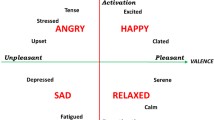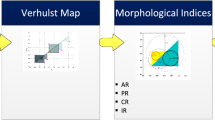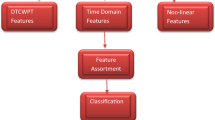Abstract
Emphatic doctor-patient communication has been associated with improved psycho-physiological well-being involving cardiovascular and neuroendocrine responses. Nevertheless, a comprehensive assessment of heartbeat linear and nonlinear dynamics throughout the communication of a life-threatening disease has not been performed yet. To this extent, we studied linear heartbeat dynamics through the extraction of time-frequency domain measurements, as well as heartbeat nonlinear and complex dynamics through novel approaches to compute multi-scale and multi-lag series analyses: namely, the multi-scale distribution entropy and lagged Poincaré plot symbolic analysis. Heart rate variability series were recorded from 54 healthy female subjects who were blind to the aim of the experiment. Participants were randomly assigned into two groups: 27 subjects watched a video where an oncologist discloses the diagnosis of a cancer metastasis to a patient, whereas the remaining 27 watched the same video including four additional supportive comments by the clinician. Considering differences between the beginning and the end of each communication video, results from non-parametric Wilcoxon tests demonstrated that, at a group level, significant differences occurred in heartbeat linear and nonlinear dynamics, with lower complexity during nonsupportive communication. Furthermore, a support vector machine algorithm, validated using a leave-one-subject-out procedure, was able to discern the supportive experience at a single-subject level with an accuracy of 83.33% when nonlinear features were considered, dropping to 51.85% when using standard HRV features only. In conclusion, heartbeat nonlinear and complex dynamics can be a viable tool for the psycho-physiological evaluation of supportive doctor-patient communication.

Scheme of the three main stages of the study: signal acquisition during doctor-patient communication, ECG signal processing and pattern recognition results.





Similar content being viewed by others
References
Benarroch EE (1993) The central autonomic network: functional organization, dysfunction, and perspective. InMayo Clinic Proceedings 68(10):988–1001. Elsevier
Jansen J, van Weert JC, de Groot J, van Dulmen S, Heeren TJ, Bensing JM (2010) Emotional and informational patient cues: the impact of nurses’ responses on recall. Patient Educ Couns 79(2):218–224
Kessels RP (2003) Patients’ memory for medical information. J R Soc Med 96(5):219–222
van der Meulen N, Jansen J, van Dulmen S, Bensing J, van Weert J (2008) Interventions to improve recall of medical information in cancer patients: a systematic review of the literature. Psycho-Oncology 17(9):857–868
Gabrijel S et al (2008) Receiving the diagnosis of lung cancer: patient recall of information and satisfaction with physician communication. J Clin Oncol 26(2):297–302
Adler HM (2002) The sociophysiology of caring in the doctor-patient relationship. J Gen Intern Med 17 (11):883–890
Fogarty LA, Curbow BA, Wingard JR, McDonnell K, Somerfield MR (1999) Can 40 seconds of compassion reduce patient anxiety?. J Clin Oncol 17(1):371–371
Gerin W, Pieper C, Levy R, Pickering TG (1992) Social support in social interaction: a moderator of cardiovascular reactivity. Psychosom Med 54(3):324–336
Uchino BN (2006) Social support and health: a review of physiological processes potentially underlying links to disease outcomes. J Behav Med 29(4):377–387
Ono M, Fujita M, Yamada S (2009) Physiological and psychological responses to expressions of emotion and empathy in post-stress communication. J Physiol Anthropol 28(1):29–35
Sep MS et al (2014) The power of clinicians’ affective communication: How reassurance about non-abandonment can reduce patients’ physiological arousal and increase information recall in bad news consultations. an experimental study using analogue patients. Patient Educ Couns 95(1):45–52
Shaw J, Brown R, Dunn S (2015) The impact of delivery style on doctors’ experience of stress during simulated bad news consultations. Patient Educ Couns 98(10):1255–1259
Reinhardt T, Schmahl C, Wüst S, Bohus M (2012) Salivary cortisol, heart rate, electrodermal activity and subjective stress responses to the mannheim multicomponent stress test (mmst). Psychiatry Res 198(1):106–111
Svetlak M, Bob P, Cernik M, Kukleta M (2010) Electrodermal complexity during the stroop colour word test. Autonomic Neuroscience: Basic and Clinical 152(1):101–107
Captur G, karperien AL, Hughes AD, Francis DP, Moon JC (2016) The fractal heartï<œembracing mathematics in the cardiology clinic. Nat Rev Cardiol 14(1):nrcardio–2016
Voss A, Schulz S, Schroeder R, Baumert M, Caminal P (2009) Methods derived from nonlinear dynamics for analysing heart rate variability. Philosophical Transactions of the Royal Society of London A: Mathematical, Physical and Engineering Sciences 367(1887):277–296
Sassi R, Cerutti S, Lombardi F, Malik M, Huikuri HV, Peng C-K, Schmidt G, Yamamoto Y, Reviewers: D, Gorenek B et al (2015) Advances in heart rate variability signal analysis: joint position statement by the e-cardiology esc working group and the european heart rhythm association co-endorsed by the asia pacific heart rhythm society. EP Europace 17(9):1341–1353
Goldberger AL, Amaral LA, Hausdorff JM, Ivanov PC, Peng C-K, Stanley HE (2002) Fractal dynamics in physiology: alterations with disease and aging. Proc Natl Acad Sci 99(suppl 1):2466–2472
Costa M, Goldberger AL, Peng C-K (2002) Multiscale entropy analysis of complex physiologic time series. Phys Rev Lett 89(6):068102
Li P, Liu C, Li K, Zheng D, Liu C, Hou Y (2015) Assessing the complexity of short-term heartbeat interval series by distribution entropy. Med Biol Eng Comput 53(1):77–87
Sunagawa K, Kawada T, Nakahara T (1998) Dynamic nonlinear vago-sympathetic interaction in regulating heart rate. Heart Vessel 13(4):157–174
Nardelli M, Greco A, Valenza G, Lanata A, Bailón R, Scilingo E (2017) A novel heart rate variability analysis using lagged poincaré plot: A study on hedonic visual elicitation, In: Engineering in medicine and biology society (EMBC), 2017 39th Annual International Conference of the, IEEE. IEEE, pp 2300–2303
Goldberger AL, Peng C-K, Lipsitz LA (2002) What is physiologic complexity and how does it change with aging and disease?. Neurobiol Aging 23(1):23–26
Wang J, Ning X, Ma Q, Bian C, Xu Y, Chen Y (2005) Multiscale multifractality analysis of a 12-lead electrocardiogram. Phys Rev E 71(6):062902
Schmitt DT, Ivanov PC (2007) Fractal scale-invariant and nonlinear properties of cardiac dynamics remain stable with advanced age: a new mechanistic picture of cardiac control in healthy elderly. Am J Physiol Regul Integr Comp Physiol 293(5): R1923–R1937
Karmakar C, Udhayakumar RK, Li P, Venkatesh S, Palaniswami M (2017) Stability, consistency and performance of distribution entropy in analysing short length heart rate variability (HRV) signal. Front Physiol 8:720
Contreras P, Canetti R, Migliaro ER (2006) Correlations between frequency-domain HRV indices and lagged poincaré plot width in healthy and diabetic subjects. Physiol Meas 28(1):85
Thakre TP, Smith ML (2006) Loss of lag-response curvilinearity of indices of heart rate variability in congestive heart failure. BMC Cardiovasc Disord 6(1):27
Goshvarpour A, Goshvarpour A, Rahati S (2011) Analysis of lagged poincaré plots in heart rate signals during meditation. Digital Signal Process 21(2):208–214
Nardelli M, Valenza G, Greco A, Lanata A, Scilingo EP (2015) Recognizing emotions induced by affective sounds through heart rate variability. IEEE Trans Affect Comput 6(4):385–394
Nardelli M, Greco A, Bolea J, Valenza G, Scilingo EP, Bailon R (2018) Reliability of lagged Poincaré plot parameters in ultra-short heart rate variability series: Application on affective sounds,” IEEE Journal of Biomedical and Health Informatics
Davis MH (1980) A multidimensional approach to individual differences in empathy
Pan J, Tompkins WJ (1985) A real-time qrs detection algorithm. IEEE Trans Biomed Eng 3:230–236
Tarvainen MP, Niskanen J-P, Lipponen JA, Ranta-Aho PO, Karjalainen PA (2014) Kubios HRV–heart rate variability analysis software. Comput Methods Prog Biomed 113(1):210–220
Acharya UR, Joseph KP, Kannathal N, Lim CM, Suri JS (2006) Heart rate variability: a review. Med Biol Eng Comput 44(12): 1031–1051
Orini M, Bailón R, Mainardi LT, Laguna P, Flandrin P (2012) Characterization of dynamic interactions between cardiovascular signals by time-frequency coherence. IEEE Trans Biomed Eng 59(3):663–673
Karmakar C, Udhayakumar RK, Palaniswami M (2015) Distribution entropy (disten): a complexity measure to detect arrhythmia from short length rr interval time series. In: Engineering in medicine and biology society (EMBC), 2015 37th Annual International Conference of the IEEE. IEEE, pp 5207–5210
Tulppo MP, Makikallio T, Takala T, Seppanen T, Huikuri HV (1996) Quantitative beat-to-beat analysis of heart rate dynamics during exercise. Am J Physiol Heart Circ Physiol 271(1):H244–H252
Guzik P, Piskorski J, Krauze T, Schneider R, Wesseling KH, Wykretowicz A, Wysocki H (2007) Correlations between the poincaré plot and conventional heart rate variability parameters assessed during paced breathing. J Physiol Sci 57(1):63–71
Piskorski J, Guzik P (2005) Filtering poincaré plots. Computational Methods in Science and Technology 11(1):39–48
Porta A et al (2007) Assessment of cardiac autonomic modulation during graded head-up tilt by symbolic analysis of heart rate variability. Am J Physiol Heart Circ Physiol 293(1):H702–8
Cortes C, Vapnik V (1995) Support-vector networks. Mach Learn 20(3):273–297
Yan K, Zhang D (2015) Feature selection and analysis on correlated gas sensor data with recursive feature elimination. Sensors Actuators B Chem 212:353–363
Chang C-C, Lin C-J (2011) Libsvm: a library for support vector machines. ACM Trans Intell Syst Technol (TIST) 2(3):27
Silva LEV, Silva CAA, Salgado HC, Fazan R (2017) The role of sympathetic and vagal cardiac control on complexity of heart rate dynamics. Am J Physiol Heart Circ Physiol 312(3):H469–H477
Silva LEV, Lataro RM, Castania JA, Silva CAA, Salgado HC, Fazan Jr R, Porta A (2017) Nonlinearities of heart rate variability in animal models of impaired cardiac control: contribution of different time scales. J Appl Phys 123(2):344–351
Benjamini Y, Krieger AM, Yekutieli D (2006) Adaptive linear step-up procedures that control the false discovery rate. Biometrika 93(3):491–507
Valenza G, Nardelli M, Bertschy G, Lanata A, Scilingo E (2014) Mood states modulate complexity in heartbeat dynamics: a multiscale entropy analysis. EPL (Europhysics Letters) 107:18003
Cysarz D, Van Leeuwen P, Edelhäuser F, Montano N, Somers VK, Porta A (2015) Symbolic transformations of heart rate variability preserve information about cardiac autonomic control. Physiol Meas 36 (4):643
Costa MD, Davis RB, Goldberger AL (2017) Heart rate fragmentation: a symbolic dynamical approach. Front Physiol 8:827
Costa M, Goldberger AL, Peng C-K (2005) Multiscale entropy analysis of biological signals. Phys Rev E 71(2):021906
Nardelli M, Del Piccolo L, Danzi O, Perlini C, Tedeschi F, Greco A, Scilingo E, Valenza G (2017) Characterization of doctor-patient communication using heartbeat nonlinear dynamics: a preliminary study using lagged poincaré plots. In: Engineering in medicine and biology society (EMBC), 2017 39th Annual International Conference of the IEEE. IEEE, pp 3473–3476
Nardelli M, Greco A, Bianchi M, Scilingo EP, Valenza G (2018) Classifying affective haptic stimuli through gender-specific heart rate variability nonlinear analysis. IEEE Transactions on Affective Computing
Nardelli M, Greco A, Bolea J, Valenza G, Scilingo E, Bailon R (2017) Investigation of lagged poincaré plot reliability in ultra-short synthetic and experimental heart rate variability series. In: Conference proceedings:... annual international conference of the IEEE Engineering in Medicine and Biology Society. IEEE Engineering in Medicine and Biology Society. Annual Conference, vol 2017, pp 2329–2332
Porta A, Gnecchi-Ruscone T, Tobaldini E, Guzzetti S, Furlan R, Montano N (2007) Progressive decrease of heart period variability entropy-based complexity during graded head-up tilt. J Appl Physiol 103(4):1143–1149
Silva LEV, Lataro RM, Castania JA, da Silva CAA, Valencia JF, Murta LO Jr, Salgado HC, Fazan R Jr, Porta A (2016) Multiscale entropy analysis of heart rate variability in heart failure, hypertensive, and sinoaortic-denervated rats: classical and refined approaches. Am J Physiol Regul Integr Comp Physiol 311(1): R150–R156
Porta A, Baselli G, Liberati D, Montano N, Cogliati C, Gnecchi-Ruscone T, Malliani A, Cerutti S (1998) Measuring regularity by means of a corrected conditional entropy in sympathetic outflow. Biol Cybern 78 (1):71–78
Guzzetti S, Borroni E, Garbelli PE, Ceriani E, Della Bella P, Montano N, Cogliati C, Somers VK, Mallani A, Porta A (2005) Symbolic dynamics of heart rate variability: a probe to investigate cardiac autonomic modulation. Circulation 112(4):465–470
Brennan M, Palaniswami M, Kamen P (2001) Do existing measures of Poincaré plot geometry reflect nonlinear features of heart rate variability?. IEEE Trans Biomed Eng 48(11):1342–1347
Spielberger CD (2010) State-trait anxiety inventory. Wiley Online Library
Ivanov PC, Chen Z, Hu K, Stanley HE (2004) Multiscale aspects of cardiac control. Physica A: Statistical Mechanics and its Applications 344(3-4):685–704
Awan I, Aziz W, Shah IH, Habib N, Alowibdi JS, Saeed S, Nadeem MSA, Shah SAA (2018) Studying the dynamics of interbeat interval time series of healthy and congestive heart failure subjects using scale based symbolic entropy analysis. PloS one 13(5):e0196823
Reulecke S, Villalobos SC, Voss A, González-Camarena R, González-Hermosillo JA, Gaitan J, Hernández-Pacheco G, Schroeder R, Aljama-Corrales T (2017) Temporal analysis of cardiovascular and respiratory complexity by multiscale entropy based on symbolic dynamics. IEEE Journal of Biomedical and Health Informatics
Author information
Authors and Affiliations
Corresponding author
Rights and permissions
About this article
Cite this article
Nardelli, M., Greco, A., Danzi, O.P. et al. Cardiovascular assessment of supportive doctor-patient communication using multi-scale and multi-lag analysis of heartbeat dynamics. Med Biol Eng Comput 57, 123–134 (2019). https://doi.org/10.1007/s11517-018-1869-1
Received:
Accepted:
Published:
Issue Date:
DOI: https://doi.org/10.1007/s11517-018-1869-1




